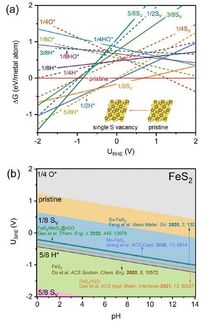A Mineral Way to Catalysis?
Fool’s Gold may prove an unlikely alternative to overexploited catalytic materials
Advertisement
Catalytic materials, which lower the energy barriers for chemical reactions, are used in everything from the commercial production of chemicals to catalytic converters in car engines. However, with current catalytic materials becoming increasingly expensive, scientists are exploring viable alternatives.
Researchers at the University of Cambridge have now discovered that the sulphide material iron pyrite, commonly known as ‘Fool’s Gold’, may hold the answer. Their findings were published in Physical Chemistry Chemical Physics.
In the past, sulphur was believed to be one of the most detrimental elements for surface chemical reactions, able to decrease dramatically the reactivity of a catalyst by occupying (poisoning) the “active sites” on the material, but more recently some sulphur materials (for example, molybdenum sulphides) have actually shown interesting catalytic properties of their own.
Using state-of-the-art electronic structure calculations, researchers led by Stephen Jenkins at the University’s Department of Chemistry, explored the potential catalytic activity of iron pyrite, the most abundant sulphur mineral on Earth. In their study, the Cambridge researchers focused on the reactions between iron pyrite and nitrogen oxides (NOx), an extremely poisonous class of compounds produced (among other sources) by car engines and industrial power plants.
Dr Marco Sacchi, the first author on the paper, said: “Recent European legislation has proposed increasingly strict legislative limits on the concentration of NOx that can be emitted by vehicles; therefore the search for new and more efficient catalysts that can capture these molecules and transform them into innocuous gases such as nitrogen and water vapour, is urgently relevant.”
Developing new catalysts derived from inexpensive minerals, instead of increasingly costly (and rare) precious metals, is an important area of research that involves several groups around the world. The next steps for the Cambridge researchers will be to investigate the activity of pyrite surfaces for strategically important industrial reactions, such as the manufacture of ammonia for fertilisers, the production of synthetic hydrocarbon fuels from renewable biomass, and the extraction of hydrogen for use in future fuel cell electric vehicles.
Dr Sacchi added: “The necessity of finding reliable alternatives to overexploited catalytic materials - such as platinum, rhodium and gold - will soon become unavoidable. Experimental work is currently underway in our group, and we hope that our work will ultimately allow us to test the potential for catalytic application of a wide range of sulphidic and carbidic materials. In future, we aim to develop fruitful scientific collaborations with chemical engineering groups and with industrial partners.”




























































